The History of New Alexandria by Dr. Richard Schaff
- Views Views: 6,377
- Last updated Last updated:
-
Check out our Partnered Grand Theft Auto 5 Roleplaying Community New Day RP!
-
Description
A Small book made by Dr. Richard Schaff after his two years spent in the State of New Alexandria.
History
PREFACE:
How people first came to this land is as varied and colorful as the people now inhabiting this land. Every group one speaks to will recall a different creation or migration story. The works in this book will not focus on pre-history but these stories shall be included. Included in this preface shall be the arguments of mainstream scientists and religious leaders as well. Feel free to observe their works and formulate your opinion. Many of the Christian Faiths currently across the country hold the belief that the natives of this land are one of the lost tribes of Israel. The Mormon faith has based a section of their literatures off such. For further readings on this, one can see Joseph Smith’s works. Prior to his works, the Spanish Church and the Franciscan orders set forward their belief systems under the “Probanzas de limpieza de sangre” which had a similar theory. There has been no evidence found currently to support this argument with artifacts. As a Historian I must go off evidence presented. I do note the current works of Sir Francis Galton and his associates with genetics and eugenics, but until this science is able to provide stronger arguments, I cannot collaborate the Lost Tribe theories or Asianic Migrations. It is not in my opinion the people of this land are of the Israeli tribes, but I cannot disprove it either. Looking into written records there are no mentions of this that I could find from original sources. However, many original sources are sadly not available due to the ravages of time. Among many scholars’ similar fields, evidence shows there was in fact a land bridge between the Continents of Asia and America. Jose de Acosta first stated this theory in the 1590’s. If one is to follow the theory of the late Jules Marcou, he supports his claims with his Geographic findings. There are currently claims and evidence to show origins of Asianic Hunters and migration. However there has been debate between many on the origin of the migrations. As of right now, all data is inconclusive, and there have been little agreement between scholars on the scientific origin of the first peoples. I will leave it to the reader to determine which story or source they find the truest to their heart of when and where they believe the first peoples came from. It shall not be the goal or objective of this book to sway political opinion, religious opinion, or to directly say the meanings behind events. Humans are shades of gray and there has never been an easy answer to a complex situation.
Chapter 1: The European Colonization.
Lemoyne, the heart of New Alexandria’s Government and economy has its roots dating back to even before the French Colonists. The area was home to many different tribes and peoples, ranging from the Natchez, Taensa, Muskogee, Yazoo, and many-many more. The first European explorers came to the region in 1528, with the Spanish expedition of Panfilo de Narvaez. It would however be the French to lay claim to this region of New Alexandria in the 1600’s. The French explorer Robert Cavalier de La Salle named the entire region the Louisiana territory, after King Louis the XIV, and that is why our Sister State of Louisiana still bears the name. The Lemoyne region was named such “The Monk” and was a surname of the Governor of the French Louisiana territory in 1701-1712, Jean-Baptiste Le Moyne, Sieur de Bienville.
Saint Denis, originally founded in 1720, named after First Bishop and patron of Paris. This city was originally a fort meant to guard the Lannahechee River, an old Muskogee word meaning “rancid yellow water”. Over the year there were migrations of more French and later Haitian colonists that melted in with the people. Over the course of several hundred years a mix of Native, African American, and European colonists formed its own culture that we know and love of Saint Denis. This land knew many flags and at times multiple countries claimed it at the same time. Napoleon in 1801 saw French troops sent to the region to ensure the French portions remained under their control, leading to conflicts with Natives, the local people, and Spain. Over the years conflicts between Spain, England, and France would see the territory change hands multiple times. However, the key events being the 7 Years war saw parts of the the Region change from French hands to Spanish hands. Other parts of the region which were still French owned were purchased by the US in 1803, but a following treaty with the Spanish in 1819 saw the area fully under US Control finally, ending the disputes between the different countries.
The modern county of Lemoyne during the early part of US history, when New Alexandria was just a territory, had sympathies and connections with the Southern Sister States. It came to no surprise to any that during the Civil War this county sided with the Confederacy. The Confederacy appointed Quincy T. Harris as a Brigadier General and put him in command of the Confederate Forces of New Alexandria.
The territory was put under the Army of the West and was considered apart of the Western Theater. It would be under General Grant’s Command that Union Forces and Union Command would occupy the region, apart of the greater Anaconda Plan, and to take control of the rivers of this region. The territory would fall to the Union, and at first engagements favored the Union, such as Copperhead Landing, in the Summer of 1862. The 3rd Lemoyne Regiment of Confederates held the area until Union Forces shelled the location. but setbacks at the battle of Scarlett Meadows, August 1864 (Remains can be seen at Bolger Glade), and the massacre of Union held Fort Brennand, May 8th, 1863 (Remains of the Fort can still be seen), saw the conflict in this region to be a bloody affair with men in the thousands being killed. The Confederacy however could not win the war of attrition and finally with the fall of Saint Denis after near a month of shelling and siege, General Harris surrendered the territory to the Union. For his defense of the land, the Quincy Harris Memorial Hall located in the North Western corner of the Central Square of Saint Denis, was built, and became a shelter for homeless veterans. This hall and many other projects of the city were built by JD McKnight (who’s Statue is by the train station) was the rebuilder of the city after the Union shelling. This rebuilding became a godsend for the land due to the prior reliance on tobacco and cash crop farming. However, with the economic turn of The War the state needed to change its economy. Now the city of Saint Denis with its manufacturing and port makes up most of the region’s revenue, supply the world with a variety of products such as the Baltz and Sheffield beer, or Old Blood Eyes Kentucky Bourbon.
The territory was put under the 5th Military District, seeing administrative control under the U.S. War Department. The First Commander of the district during Reconstruction was General Philip Sheridan. However, he was removed by U.S. President Andrew Johnson and replaced with Charles Griffin. The next and last Commander being Joseph J. Reynolds in 1870 military occupation of the area was lifted. During the occupation, Forces of Note that occupied the area would be the US. 1st Artillery, 4th, 6th and 9th Cavalry, and the 15th, 17th, 20th, 25th, and 41st Infantry Regiments.

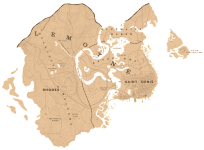
New Austin – Last of the old west, Home to Tumbleweed and Armadillo. Notable sites include the Border to Nuevo Paraiso (New Paradise) the strip of Land on the other side of the San Luis River this state has bordering Mexico. The San Luis River cutting the border, a similar naming of Saint Louis, just the Spanish Version thereof, ends in the Sea of Coronado, meaning the Crown Sea or the Sea of Crowns. Which is appropriate as it is at the head of the river and crowns the region.
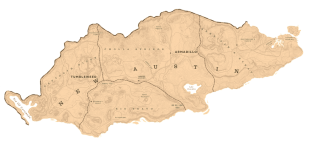
Ambarino – Home to mountains and trees, this land is a rugged country and home to a rugged people. The Wapiti and the Arrikoan call it home, as have and do other native peoples. The area even holds itself to the names of the Grizzlies East and the Grizzlies West. Due to the mountains of the area, there are a host of mountain peaks and a Big Valley that runs through it. Home to Strawberry, Colter, the homes of the Natives mentioned earlier, this area sees itself as one of the last true frontiers in the country.
Marked borders would include the Mountains of the North, the Dakota River and Roanoke Ridge to the East, and the Cumberland Forest to the South. Currently the region finds itself under the State County control of West Elizabeth in regards to representatives in the State House.
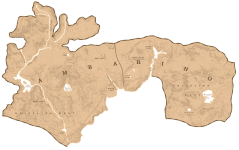
West Elizabeth – The early steps of Westernization can be seen here with the building of Blackwater, butted up against the wilds of the rolling hills and Great Plains. Bordered by the San Luis River, the Lower Montana River, the Heartlands, Tall Trees, and the Dakota River, this region sees its biggest asset commercially in the trade and commerce from Flat Iron Lake.
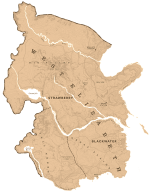
New Hannover – Home to the open plains of the Heartlands, the great Cumberland Forest, and the rocky Roanoke Ridge, this territory is the shield of Lemoyne both geographically and politically. It has known Colonial settlers from Europe, mainly French and German since the 1790’s. New Hannover is named after Hannover in the German Empire, an area loyal to the English Monarchs during the time of settling.
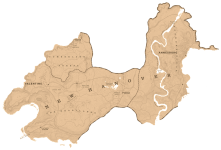
Chapter 2: Settlements
Annesburg – Similiary named to a town that would be in Germany, where many of the residents are from or their family are from. The industrial hub of New Hannover (Also named after a region in Germany). Here the coal needed to fuel the fires of industry is mined and the great trains run in and out of the town fueling Saint Denis and many of other towns and states on around the clock basis. Built in late 1790’s by German migrants, this town has known over a century of mining, and this has now seen its effects on the local water.
During the Civil War, the town was quickly occupied by Federal Forces. Due to the railroads and coal productions, this area was too vital for the Union to let go and fierce fighting occurred in the surrounding areas. As evident by the ruins of Fort Brennand, a former Union fort that was burnt and the occupancy inside slaughtered by Confederate General Quincy.
Armadillo – setting in the center of Cholla Springs, the center of New Austin and one of the final stops of the Railroad system of New Alexandria before crossing into our Western Territories and onto California. A boom town due to the local gold mines, the perfect location for traveling out west, and for being nestled in a geographically convenient location, this town knew a great deal of prosperity early on. Disease however struck the town in 1898-1899. A great Cholera pandemic saw the town suffer. This saw to the local Chapel grow a large number of head stones and sadly a larger number of mass graves. The town has slowly tried to crawl its way back, but many have now viewed the town as a den of villainy and where Outlaws go to rest their heads. This idea has even given birth to the business of “Outlaws’ Rest” at the town saloon.
With the local Train stops of Benedict Point and with the Plainview oil site nearby, maybe this new found Black Gold (Oil) will see the region boom again.
Blackwater – rumored to have once been a native fishing village, this area’s history was sadly not recorded until the 1800’s when settlers from Saint Denis began to build it up as a trade port. Soon it grew and in the 1870’s the town began to modernize. Now with the start of the 1890’s the town began to be the Jewel of the West as the first modern town of the State West of Saint Denis. (With exceptions of those in California)
Braithwaite Manor – A former plantation, after the Civil War the area was seized by Federal forces and soon found itself to be the home of the Marshalls’ office. Now fully in State control, the area is known to provide work for those seeking it as a field hand.
Butcher’s Creek – Named after the small body of water that runs through it, this town is known to keep to itself. This town has always known itself to be the spot of run-aways from big Government and city life. Here the folk enjoy a secluded lifestyle, and they wish to keep it that way.
Caliga Hall – A plantation that was not ruined by the Civil War but has started to see its downturn due to economic crash after The War. Many of Saint Denis are still not happy with the conditions the farmhands are subject to working the numerous acres of fields, leading to a push for more industrialization.
Colter – A mining town, known for its harsh conditions, the town saw its boom in the 1880’s, and sadly its downfall. Some say the mine dried up, others that the gold wasn’t worth the big storms. Regardless, the town still stands to those brave enough to endure the winter conditions.
Emerald Station/Ranch – Once native hunting grounds for grazing buffalo, this flat area soon saw its use by colonial settlers moving out of Saint Denis as a major cattle grazing area. Over time permanent structures began to be built in the early 1800’s and in time the rail lines made it a stop to unload and load cattle and other livestock. During the Civil War, this was the stomach of the Union forces laying Siege to Saint Denis. Supplies from the North were able to be sent down to New Alexandria and it was here the majority of the Federal Forces saw their supplies and ammunition to continue starving out and shelling the city.
Fort Wallace – Built in the 1870’s during the Military Occupation of the South and during the last of the Indian Wars of the region. This Fort has seen constant federal use since its founding, an always present reminder of Uncle Sam and his ever-ready heavy hand.
Lakay and the twin Lagras– Home to a people as onery as the alligators in the surrounding swamp, this area knows little influence of the State even though it is close to the heart of the state (Saint Denis).
Rhodes – Named after Brigadier General of the United States Army, Sherman M. Rhodes. Nestled in Scarlett Meadows Lemoyne, the town was founded in the early 1800’s. The town had men serve in the Civil War, due to the high casualties a statue was erected in the center of the town.
1861-1865
To the Three Thousand two hundred and two unknown soldiers gathered from the slopes of Carmody Hills to the Banks of the Dakota River. Their remains could not be identified but their valiant acts were recorded in words of their leader, Major Hobart H. Crawley, whose miraculous survival at the head of the charge on the morning of March 30th, 1863 means their sacrifice will never be forgotten.
May they rest in peace.
Shady Belle – A plantation that saw its ruin at the end of the Civil War.
Strawberry – A logging town that has seen its share of travelers, has now grown to see gold miners and hunters, wishing to make a name for themselves in the frontier. This town is self-reliant, and the people share this attitude. Founded in the 1840’s, it has known near 60 years of an independent attitude.
Thieves Landing – Nearly as old as the territory itself, it had always been a hub for scum and villainy. Known for its smuggling of illegal goods through the ages, either it be due to European taxes or black-market trade due to U.S. sanctions, this region has always known shadowy trade.
Tumbleweed – Nestled in Gaptooth ridge, the Western part of New Austin. A once bustling town due to the gold rush. It saw a massive decline once industrialization and the Railroad gripped the land. Not connected to the railroad, and due to a dry up of the gold mines, it was found it was no longer needed as a stop by town for supplies. The town it found itself at the mercy of those brave enough to track a wagon down to it with supplies for a few dollars. Many of the surrounding homesteads, such as Rathskeller Fork, have fallen to disrepair due to the lack of opportunity and neglect.
Van Horn – Built to be the Twin of Saint Denis with initial thoughts, the town of Van Horn soon found itself unable to sprawl much larger due to the hard mountain stone that had to be carved into to expand. Limited by the landscape, the town was reduced to keeping to a moderate size but still maintained a modern feel. However, in the 1860’s this was to end when the town saw massive destruction by Union Naval shelling and future neglect by the territory and later state as time went on. Since Saint Denis was already the main focus of reconstruction, Van Horn was left to its own, and 30 years later the people and town both still carry the scars of neglect.
Valentine - Said to have been built over a burial ground, or to have been the last stand of a native people before being massacred, the origin of Valentine has always been a mystery. Always in a constant state of flux, either expanding or shrinking, it seems to breath with the state. Being the center point, the axel of the wagon wheel essentially, all town roads lead to here in way or another. This brings near every traveler through this town, for better or worse.
Chapter 3:
Major Events in 1898-1900
December 19, 1898, the Territory pushes Congress for the name New Alexandria and starts the State Hood process.
January 5th 1899, Francis Devine appointed Governor Pro-Tempore.
February 1st, New Alexandria Constitution, Criminal Code, and General Laws ratified.
February 9th, First Trial State of New Alexandria v. Edward Zoski.
February 24th, Medieval Relief Trip in response to New Austin Cholera Outbreak.
February 29th First Governor's Election Opens.
March 1st, State Judiciary of New Alexandria Established, Chief Justice James Tully Appointed.
March 4th, First Wapiti Treaty Established by Governor Frank Devine and Chief Tecumseh
March 14th New Alexandria Sheriff's office Established
March 28th First Governor Debate.
April 3rd-5th, 1st Election. Frances Devine Elected Governor.
May 9th, First Business License.
May 15th, Telegraph System introduced.
May 22nd-24th May Election - Elected Addison Flanagan, Clint Masterton, and Elydia Darkmoon for State Representatives.
June 11th, First State Adoption.
July 13th, Bounty Hunting introduced.
July 15th, 2nd Wapiti Treaty
July 20th, George Cook becomes Sheriff of the East.
August 7th-9th, Governor elections, Addison Flanagan, and State Representatives, Henry Clerk, Ada "Dove" Lockwood and Ramona Ryder.
August 22nd, Jeremia Jackson becomes Sherriff of the East.
August 28th, Markus Underwood Becomes Chief Justice.
September 9th, An Illness Sweeps the State, taking Valentine.
September 1th, MacFarlane's Ranch becomes the Quarantine Zone.
September 22nd, Army Arrives.
September 28th, Plague Eradicated, Federal forces withdraw.
October 6th, First Secretary of State Halbert Deriot
October 8th, Adelaide Holloway becomes State Representative.
December 4th-6th, Election for Governor Addison Flanagen, and State Reps' Adelaide Halloway, Zurgadai "Jim" Baghatur, and Ramona Ryder. Jaena Shaw Appointed first Surgeon General.
December 7th, The Controversial "Dump the Pump act of 1899" is ordered by Addison Flanagan. This act banned Pump Action Shotguns in the State. Sparking outrage, militias and a few rebels to spring up across the state, but they were quickly put down.
ADDITION: Year 1900 - 1901
January 28th, efforts lead by Adelaide Joyce saw to a community effort to install and build a Telegram Station in Colter.
February 4th, the State is hit with a scandal that Chief Justice Lana Molotov at the time was running Businesses illegally and granting illegal favors by accusation of a deputy.
February 14th, reports of a gang calling themselves "Comanche" begin to attack citizens in New Austin. A "War Chief Two-Swords"(real name Thatcher Ford) and "Chief Looks-For-War" (real name Double Tongue).
February 15th, - The Governor's Award is established with Jaena Shaw and James Hollister were the first awarded such medals. Heritage Sites is also ordered, giving certain areas across the state a protective Status.
March 4th, a State Scandal rocks state as a rumors of Representative Ramona Ryder had committed crime and had not faced serious punishment for their crimes made the rounds of rumors. Due to unknown circumstances behind the curtains of the Government, Ryder stepped drown from office and left the State.
March 9th, Lawrence Carnegie is made Chief Justice.
March 12th, the United States Military is called in to put down the gangs of New Austin. Within a week of soldiers being deployed, the rebels and "Comanche" gangs vanish from the state.
April 19th, Chief Justice Lana Molotov Steps down.
April 22, Jaena Shaw is elected Governor of New Alexandria with Liberty Hollister, Ulysses Murray, and Dexter Silo as State representatives. Zurgadai "Jim" Baghatur as Attorney General and Lauren Taylors as Surgeon General.
May 14th, Jack Burton steps down from being Sherriff.
July 10th, Lauren Taylors the Surgeon General is killed.
July 30th, a Treaty is signed between the "Natives" and Jaena Shaw.
August 20th, Zurgadai "JIM" Baghatur is elected Governor, with Adelaide Joyce as Secretary of State, Sasha Strogonav as Secretary of Buisness, Emma Baily as Secretary of Press, Metea Shaw as Surgeon General, Jean Holt as Temp Attorney General, Liberty Hollister, Marvin Logue, and Alice Hopkins as State Representatives.
August 29th, the Sherriff's department has a mass munity, causing the stepping down of over 30 deputies, and the forced removal of Marshal's Molly Ray and Jeremiah Jackson. In the deputies who stepped down was Sherriff Antonio Delgato.
September 6th, the Committee of Business, COB for short, was fully staffed and established.
September 4th, Executive order 028 "Criminal Reform" is pushed, completely changing the times and fines associated to the laws of New Alexandria.
September 10th, Ethan Colt of the Colt gang is captured and sentenced for his crimes against the state and the murder of Ruby Colt.
September 18th, Chester Williams steps down from Sherriff.
September 22nd, Jack Carter is made Sherriff.
September 25th, a group of strange masked killers known as the "Faceless" were sentenced to death after a near year of banditry. Hardey Freeman of the Freeman gang was also sentenced to death, ending the reign of terror of the Freeman gang. The Cossacks, another notorious gang, was also arrested and sent to prison.
September 29th, Audrey Fowler is made State Marshall.
October 2nd, James Walter is made Sherriff.
October 4th, Liberty Hollister Steps Down from being State Rep. in a very public manner with association to Assistant Attorney General Patrick Collins, where the couple is mocked by the State due to their public outburst.
October 5th, the Sherriff's office and Marshall's office is completely overhauled. Sherriffs are elected by the deputies and the Marshall's office folds under the Governor's Cabinet. The department is split into three jurisdictions.
October 7th, Max McQueen, Lillianah Dagouter, Wayne Dagouter, and Antonio Delgato are appointed Deputy State Marshals.
October 8th, Robert Barlow is made the new state rep.
November 5th, a hurricane and storm strikes New Alexandria, causing the US Military to get involved to help the State.
November 8th, Milo Reines is made Sheriff.
November 28th, Zurgadai "JIM" Baghatur steps down from Governor due to health issues.
November 30th, Audrey Fowler is acting Governor till tragically killed in a duel.
December 4th - 18th Max McQueen is acting Governor.
December 18th, Sam Holt is elected Governor of New Alexandria with Isabella Tremblay as Secretary of State, Metea Shaw as Surgeon General, Zurgadai "JIM" Baghatur as a temp Attorney General, Emma Baily as Secretary of Press, Sasha Strogonov, Robert Barlow, and Tayen Jones as representatives.
Addition: 1901-1902
January 31 - Leopold King, Jean Holt, and Aaron Hunter appointed Deputy State Marshals.
Febuary 1 - James Walker is no longer Sheriff.
February 21 - Yellow Fish, an infamous criminal with the Fish Gang (each fish being a separate color) was put on trial for treason.
February 23 - Lorenzo Roussan was sworn in as Sherriff.
March 11 - Jean Holt is no longer Deputy State Marshal
March 14 - Antionio Delgato is no longer Deputy State marshal
March 28 - Wayne and Lillianah Dagouter are no longer Deputy State Marshalls.
April 8th - Robert Barlow is elected governor, with represantitives Raven McCoy, Lyle Whitney, and Autumn O'Connell.
April 11 - Raven McCoy resigns. Grace Watson steps in as representative.
April 19, Metea Shaw is no longer Surgeon General
April 29 - Barlow's Cabinet is sworn in: AG - Eira McCormick, Secretary of State - Simon Thatcher, Secretary of Business - Isabella Tremblay, Secretary of Press - William Henry, Surgeon General- Callum Conroy.
May 6 - Autumn O'Connell steps down from being State Rep. Adelaide Shaw is placed as representative by the Government.
May 21 - Constitutional Convention held to pass and ratify the Second Constitution of the State of New Alexandria authored by Chief Justice Lawrence Carnegie. In attendance at the Convention, State Representative Grace Watson, Adelaide Shaw, Lyle Whitney, Governor Robert Barlow and Chief Justice Lawrence Carnegie. Elythra Randella was sworn in as the first Secretary of Native Affairs.
May 22 - Elizabeth Ashbrook, Malcom Ashbrook, Darion Rueb, and Jack John are sworn in as Deputy State Marshals.
June 1 - Simon Thatcher is dismissed as Secretary of State.
June 9 - Hannah Holland dies in office as Warden of Sisika.
June 13 - Kenzie Winters sworn in as Secretary of State.
July 8th, Petra Blackhart is Warden of Sisika.
July 15 - State Animal (Racoon), State Bird (Horned Owl), State Flower (Lavender), State Tree (Sequoia), and State Motto (Perseverance Conquers All) is established.
July 18 - Eira McCormick fired from Attorney General position.
July 27 - Department of Prisons established.
August 2 - Extradition treaty signed with Guarma.
August 6 - Max McQueen has resigned. Hannah Westbrook confirmed as new State Marshall.
September 1 - Robert Barlow is appointed Secretary of States, Alexander Dray appointed Attorney General.
September 15th - Chief Justice Lawrence Carnegie holds a meeting of the Judges of New Alexandria and informs them that he is planning to resign. Chief Justice Lawrence Carnegie starts the election process and on the same day, a new Chief Justice is elected. William Murphy becomes Chief Justice-Elect.
September 21st - Chief Justice Lawrence Carnegie, after over 1.5 years of being Chief Justice, publicly announces that he plans to resign and that he held a meeting of the Judges to find his successor.
September 22nd - Chief Justice Lawrence Carnegie formally resigns and becomes the first state judge to become Federal Judge of the Federal Thirteenth District Court. William Murphy becomes Chief Justice.
October 6th - Markus Underwood becomes the second state judge to become a Federal Judge of the Federal Thirteenth District Court.
October 14 - Governor Elythra Blue resigned as Governor. Robert Barlow stands in as Governor.
October 24 - Malcolm Ashbrook resigns as Deputy State Marshal.
October 26 - Elizabeth Ashbrook sworn in as Attorney General
November 9 - Livestock Commission Established.
November 20 - Sheriff Jack Carter and Milo Reines have their terms end.
November 23 - Jen Acree sworn in as Sheriff
December 10 - Robert Barlow is elected Governor with Elizabeth Ashbrook as AG, Secretary of State Sasha Stroganov, Secretary of Buisness Isabelle Tremblay, Secretary of Press William Henry, Surgeon General Callum Conroy. Represenatives being Fern Wilder, Poppy Beckett and Timothy O'Boyle.
Rumor(s)
The works here are that of Dr. Richard Schaff based on his findings and his opinion. Take everything with a grain of salt.

Information
Date of Origin:
1899-1900
Relevant Location(s):
State of New Alexandria's Public Librarys
-
Loading…

